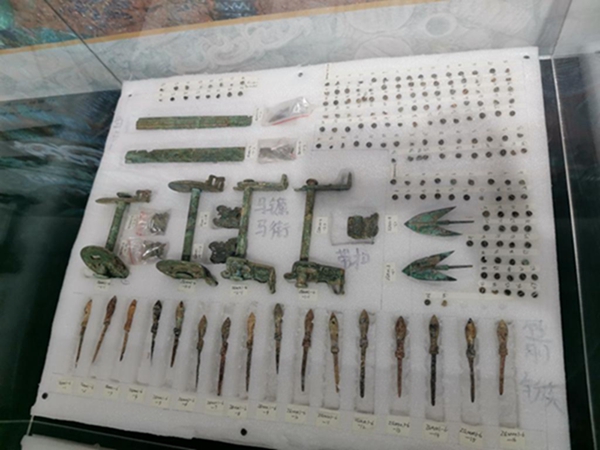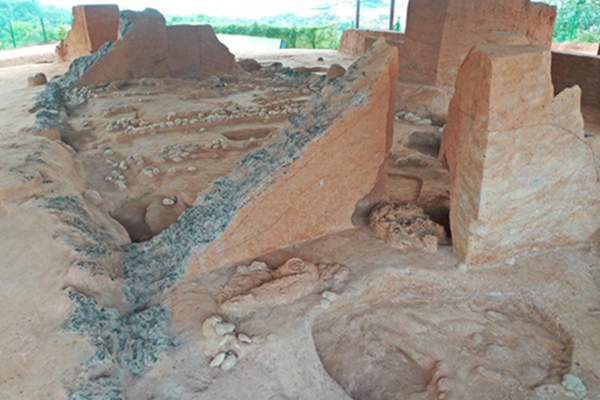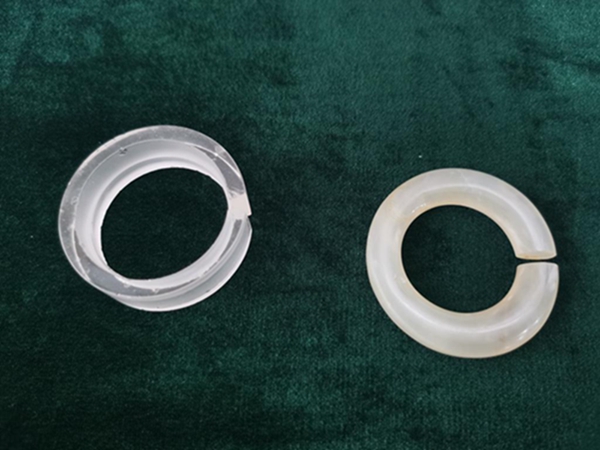|
Xinhua News Agency, Hangzhou, November 11 (Reporter Feng Yuan) During the Shang and Zhou Dynasties, there was an active ethnic group called "Gumei" in the central and western regions of Zhejiang today, but their records in ancient history were not systematic and complete. Archaeologists in Zhejiang Province have found a high-class tomb group of the Western Zhou Dynasty in Qujiang District, Quzhou City, western Zhejiang Province, after four years of research. Experts believe that it may be the mausoleum of Gumei State. 
The picture shows some primitive porcelain unearthed from Tomb 3 of Mengjiang. Photographed by Feng Yuan, a reporter from Xinhua News Agency This tomb complex is located on the north bank of Qujiang River in Yunxi Township, Qujiang District. Ten tombs have been found and six have been officially excavated. Zhang Sen, assistant librarian of Zhejiang Institute of Cultural Relics and Archaeology, said that two of the six tombs were excavated in the 1980s and 1990s. The other four will be excavated from 2018 to 2021 by Zhejiang Institute of Cultural Relics and Archaeology in conjunction with Qujiang District Cultural Department with the approval of the State Administration of Cultural Heritage. They are Miaoshanjian Mound Tomb and Mengjiang Mound Tomb No.1, No.2 and No.3. A large number of jade, primitive porcelain, bronze and other artifacts have been unearthed. 
The picture shows some bronze chariots and horses unearthed from the mound tomb at the tip of Miaoshan Mountain. Photographed by Feng Yuan, a reporter from Xinhua News Agency In the mound tomb at the tip of Miaoshan Mountain, archaeologists found bronze chariots and horses of the Western Zhou Dynasty for the first time in Zhejiang. They have exquisite shapes and unique patterns. The earliest "herringbone" wooden outer coffin structure in China was unearthed in Tomb No. 1 of Mengjiang. This construction method is to use wooden boards outside the coffin to form a "herringbone" outer coffin, and then fill the outer coffin with charcoal first and then with mellow soil. Tian Zhengbiao, a researcher of the Zhejiang Provincial Institute of Cultural Relics and Archaeology, once presided over the discovery of the first high-level aristocratic cemetery in the State of Yue. He said that the construction method of Meng Jiang Tomb No. 1 has many similarities with that of later Yue tombs. Its burial level is the highest in the Yue area of the Western Zhou Dynasty, and it should be a royal tomb. 
The picture shows Meng Jiang's tomb No. 1, where the earliest "herringbone" wooden outer coffin in China was unearthed. (Figures provided by interviewees) Another important discovery of Meng Jiang's Tomb No. 1 is the "revival of Jue". Six groups of jade rings, about 200 pieces each, were unearthed from the tomb. At present, the known jade Jue first appeared in the Xiaonanshan site in Heilongjiang Province, which has a history of 9000 years. Since then, it has appeared at Xinglongwa Site in Inner Mongolia 8000 years ago. Later, the Jade Jue "went south" to the lower reaches of the Yangtze River and appeared at Majiabang, Hemudu, Songze, Lingjiatan and other sites. Researcher Fang Xiangming from the Institute of Cultural Relics and Archaeology of Zhejiang Province said that after that, jade jue disappeared for a period of time, and it was revived in the Shang and Zhou Dynasties. The area where the jade ring was unearthed should be the "renaissance place" of the ring in Baiyue during the Shang and Zhou Dynasties. This group of Jue decorations even spread to the Dian State from the Warring States Period to the early Western Han Dynasty, which is today's Yunnan area. Mengjiang Tomb No. 3 is the largest mound tomb of the same period in Zhejiang. The remaining mound is about 70 meters in diameter, and more than 200 pieces (groups) of burial objects have been unearthed. Among them, primitive porcelain is the most exquisite. Zhang Sen said that in combination with carbon 14 isotope dating and analysis of unearthed artifacts, the construction time of these tombs should be late from the early Western Zhou Dynasty to the middle Western Zhou Dynasty. 
This is part of the ring unearthed from Tomb No. 1 of Meng Jiang. The left is a crystal ring, and the right is a chalcedony ring. Photographed by Feng Yuan, a reporter from Xinhua News Agency Earth mound tombs were popular in Jiangnan from the Western Zhou Dynasty to the Spring and Autumn Period. People built earth mounds on flat land and buried the dead on the top of the mounds. Lin Liugen, a professor of Zhejiang University, has long been engaged in archaeological research on mound tombs. He said that the burial method of building mounds has always influenced the tomb sealing system of later generations. This discovery is an important breakthrough in the study of mound tombs. They should belong to high-level noble tombs, in other words, the royal tombs area. Chen Yuanfu, a researcher from the Zhejiang Provincial Institute of Cultural Relics and Archaeology, said that compared with the Yue Tombs in northern Zhejiang, these tombs had some similarities, but also had strong local characteristics. Considering their high level, they should be related to the Gumei State at that time, which belonged to the royal tomb level. 
The picture shows the original porcelain unearthed from Mengjiang Tomb No. 3. Photographed by Feng Yuan, a reporter from Xinhua News Agency "This discovery is a major discovery of Western Zhou archaeology, an important breakthrough in Baiyue archaeology, and the nature of the remains is most likely the Tomb of Gumei King." Wang Wei, member of the academic department of the Chinese Academy of Social Sciences and chairman of the Chinese Archaeological Society, said that this discovery is of great significance to the study of jade inheritance, the origin of primitive porcelain, the development of the burial system and other major topics. Yang Jianwu, member of the Party Leadership Group of Zhejiang Provincial Department of Culture and Tourism and director of the Provincial Bureau of Cultural Relics, said that the tomb here is the highest ranking Western Zhou tomb in Zhejiang Province, and there are still many mysteries to be solved. Therefore, the cultural relics department will further strengthen protection and do a systematic archaeological investigation.
|